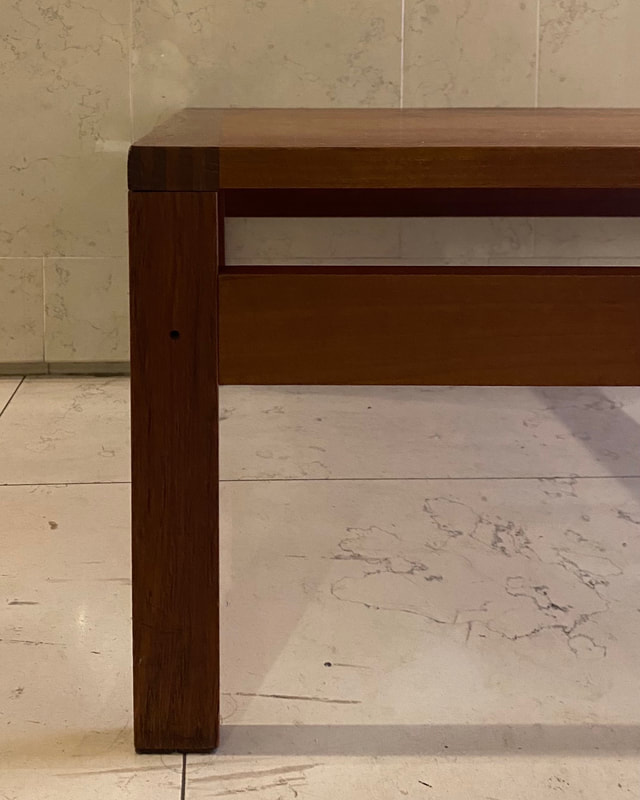FRANCE & SON
France & Daverkosen - sono oggi tra i nomi più ricercati nel mercato vintage. Molti pezzi ancora in circolazione mantengono la loro etichetta originale e sono stati disegnati dai più importanti designer danesi del Mid-Century.
Molte fonti sono d'accordo sul fatto che la popolare azienda sia stata fondata in Danimarca intorno al 1948 dall'imprenditore britannico Charles W. France e dall'ebanista danese Eric Daverkosen. Specializzata all'inizio forse in materassi, già nel 1952 France & Daverkosen possiede una grande fabbrica di mobili a Hillerød, poco fuori Copenaghen, diventando poi in breve una delle aziende di arredamento più famose in Danimarca, dedicata alla produzione in serie piuttosto che ai tradizionali metodi artigianali. Sedute con cuscini larghi e strutture leggere in teak sono i segni distintivi di France & Daverkosen.
Nel 1957, quando il figlio di France, Julian, si unisce all'azienda, il nome cambia e diventa France & Søn.
Probabilmente il successo di France & Søn nel mondo della produzione in serie ha contribuito alla scarsezza di informazioni storiche, in quanto la grande quantità della sua produzione ha contribuito a non renderla "speciale". Un articolo giunto fino a noi rivela che France & Søn sia stata forse la prima manifattura di mobili - sotto la direzione di Finn Juhl - a capire come lavorare efficacemente il teak su scala industriale, impressionante nell'era modernista. La sedia Model 133 Spadestolen (1953) di Juhl ne è stato il primo risultato.
France & Daverkosen—are among the most sought after names on the vintage market today. Numerous pieces that are still in circulation retain their original identifying labels and were designed by major midcentury Danish designers, like Hvidt & Mølgaard, Grete Jalk, Finn Juhl, Arne Vodder, and Ole Wanscher. It's surprising, then, that so little information about the company's history and evolution has survived.
Most sources agree that the popular Danish manufacturing firm was founded in Denmark around 1948 by British businessman Charles W. France and Danish cabinetmaker Eric Daverkosen. Mattresses may have been the company's first focus, but by 1952 France & Daverkosen had built a large furniture factory in Hillerød, just outside of Copenhagen, and was fast becoming one of most successful Danish furniture companies dedicated to mass production rather than traditional artisanal methods.
Seating that features loose cushions and light, teak frames became France & Daverkosen's signature.
In 1957, when France’s son Julian France joined the company, the name was changed to France & Søn.
Arguably, France & Søn's success in the arena of mass production contributed to its lackluster coverage by design historians; the sheer quantity of its production may have interfered with creating an aura of "specialness." Yet, one surviving story claims that France & Søn was the first—under the direction of Finn Juhl—to figure out how to work with teak at an industrial scale, an impressive feat in the modernist era. Juhl's Model 133 Spadestolen Chair (1953) was the first result.
France & Daverkosen - sono oggi tra i nomi più ricercati nel mercato vintage. Molti pezzi ancora in circolazione mantengono la loro etichetta originale e sono stati disegnati dai più importanti designer danesi del Mid-Century.
Molte fonti sono d'accordo sul fatto che la popolare azienda sia stata fondata in Danimarca intorno al 1948 dall'imprenditore britannico Charles W. France e dall'ebanista danese Eric Daverkosen. Specializzata all'inizio forse in materassi, già nel 1952 France & Daverkosen possiede una grande fabbrica di mobili a Hillerød, poco fuori Copenaghen, diventando poi in breve una delle aziende di arredamento più famose in Danimarca, dedicata alla produzione in serie piuttosto che ai tradizionali metodi artigianali. Sedute con cuscini larghi e strutture leggere in teak sono i segni distintivi di France & Daverkosen.
Nel 1957, quando il figlio di France, Julian, si unisce all'azienda, il nome cambia e diventa France & Søn.
Probabilmente il successo di France & Søn nel mondo della produzione in serie ha contribuito alla scarsezza di informazioni storiche, in quanto la grande quantità della sua produzione ha contribuito a non renderla "speciale". Un articolo giunto fino a noi rivela che France & Søn sia stata forse la prima manifattura di mobili - sotto la direzione di Finn Juhl - a capire come lavorare efficacemente il teak su scala industriale, impressionante nell'era modernista. La sedia Model 133 Spadestolen (1953) di Juhl ne è stato il primo risultato.
France & Daverkosen—are among the most sought after names on the vintage market today. Numerous pieces that are still in circulation retain their original identifying labels and were designed by major midcentury Danish designers, like Hvidt & Mølgaard, Grete Jalk, Finn Juhl, Arne Vodder, and Ole Wanscher. It's surprising, then, that so little information about the company's history and evolution has survived.
Most sources agree that the popular Danish manufacturing firm was founded in Denmark around 1948 by British businessman Charles W. France and Danish cabinetmaker Eric Daverkosen. Mattresses may have been the company's first focus, but by 1952 France & Daverkosen had built a large furniture factory in Hillerød, just outside of Copenhagen, and was fast becoming one of most successful Danish furniture companies dedicated to mass production rather than traditional artisanal methods.
Seating that features loose cushions and light, teak frames became France & Daverkosen's signature.
In 1957, when France’s son Julian France joined the company, the name was changed to France & Søn.
Arguably, France & Søn's success in the arena of mass production contributed to its lackluster coverage by design historians; the sheer quantity of its production may have interfered with creating an aura of "specialness." Yet, one surviving story claims that France & Søn was the first—under the direction of Finn Juhl—to figure out how to work with teak at an industrial scale, an impressive feat in the modernist era. Juhl's Model 133 Spadestolen Chair (1953) was the first result.


